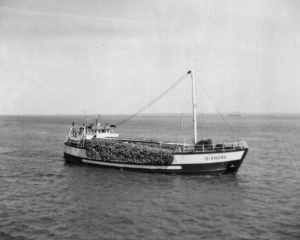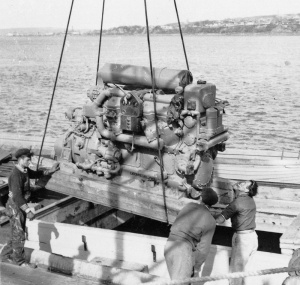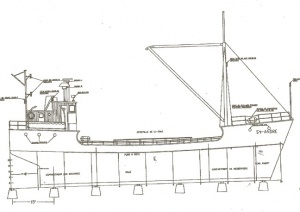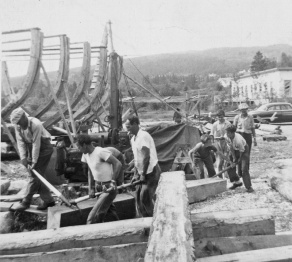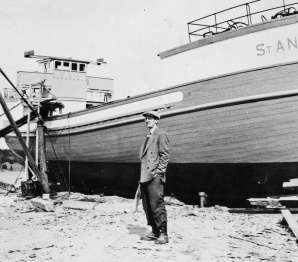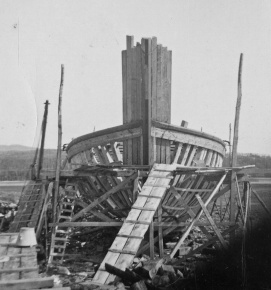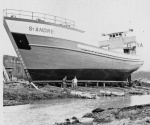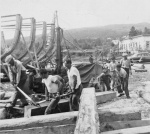The schooner Saint-André, a jewel of the Charlevoix Maritime Museum
par Bélanger, Diane
The schooner Saint-André was built in 1956 at La Malbaie, in Charlevoix County, by master carpenter Philippe Lavoie, one of the last schooner builders of the Saint Lawrence. Its owner, Captain Fernand Gagnon, engaged in coastal trading on the Saint Lawrence, mainly between Montreal and Sept-Îles, until 1976. At that time wooden schooners were replaced by metal ships, which were much larger, more profitable and better adapted to winter navigation. The Saint-André, one of the last witnesses to Quebec's particular long maritime tradition, was classified as a cultural property in 1978. Recently restored, it is conserved at the Charlevoix Maritime Museum, near the shores where it was born.
Article disponible en français : Goélette Saint-André, joyau du Musée maritime de Charlevoix
Charlevoix's long maritime tradition
Quebec settlers along the great Saint Lawrence River have long worked in naval construction and navigation. For about 200 years, river transport was the only way for cities and towns to be established and provisioned. This is particularly true in Charlevoix County, where in times past the Laurentian Mountains isolated the people living along the shore. From the beginning of their history, the people of Charlevoix developed a rich maritime tradition. Their need for provisions led to coastal trading by means of locally-built ships, manned by sailors skilled at navigating on the river in conditions that were often very difficult. The shipyard established in the bay of Saint-Joseph-de-la-Rive is one of the major witnesses to this rich heritage. Transformed into an in-situ museum, it makes possible the conservation and interpretation of Charlevoix's maritime tradition. Two schooners, the Jean Yvan and the Saint-André, evoke this tradition. The Saint-André was classified as a cultural property by the government of Quebec in 1978.
Schooners on the Saint Lawrence River
Though the origin of the word goélette (schooner) is unknown (NOTE 1), schooners are known to have been in New France since the end of the seventeenth century. Gradually, this kind of ship replaced the other kinds that were used at the beginning of French colonization. By definition, a goélette is a sailboat with two masts. The foremast is shorter than the aft mast, and the sails consist of lugsails and triangular sails. The schooner, known for its ease of handling and maneuverability, soon became the most frequently used kind of ship for Quebec sailors, who could have them built on the shores of the river by carpenters skilled in naval construction. The abundance of high-grade wood for constructing small and medium-sized craft contributed greatly to their quality.
The presence of sailing schooners in Charlevoix was noted as early as the beginning of the nineteenth century. The kind of schooner made by Charlevoix carpenters was similar to the "American" schooner widely used by fishermen of the Atlantic coast. A "French Canadian" type of schooner soon developed, differing from the American one by its flat bottom, which allowed it to land on river shoals. The people living on the shore could reach the ships at low tide to load them with merchandise. Beginning in the 1920s, as schooners were motorized, they served as efficient coasters for the wood trade. The years from 1935 to 1960 were the golden age of the Saint Lawrence schooners, with industrialization of the Côte-Nord, construction of the first major Hydro-Quebec dams, and development of the pulp and paper industry. Captain Fernand Gagnon's schooner Saint-André represents the perfection of this small artisanal industry.
The Gagnons: navigation as a family tradition
The Saint-André's owner and captain, Fernand Gagnon, came from a family of sailors. His father, Captain Joseph Gagnon, had the small ship Le Charlevoix built in 1922, then the schooner Comté Charlevoix in 1935. Fernand Gagnon learned the rudiments of his calling on the latter. As this schooner's trade would not support two families, the younger Captain Gagnon had long wanted to build his own schooner. On a pilgrimage to Saint Joseph's Oratory in Montreal, Fernand Gagnon made a vow to Brother André: "If I succeed in building my boat, I will call it the Saint André."
The challenges were considerable. First, he had to raise $80,000, a large amount of money at the time. Then there was the problem of wood, which was becoming hard to get in the Charlevoix mountains. It occurred to Fernand Gagnon to ask the owner of the Cabot seigneurie to let him cut the wood on her land, where enormous trees including red, white and grey pines were abundant. Finally, Madame Cabot agreed to sell him a timber permit. Fernand Gagnon and his two sons, Claude and Michel, spent a winter cutting the necessary wood. Construction of the schooner Saint-André could then begin.
Construction of the Saint-André
Construction of the Saint-André began on 5 July 1955, near the dock of La Malbaie. Master carpenter Philippe Lavoie of Petite-Rivière-Saint-François, one of the best and also one of the last master carpenters of Charlevoix, was in charge. The carved wooden model was perfect. After the keel was laid, the ribs that were to form the skeleton of the ship were cut and installed. The work took five months, and was carried out by a team of ten workers, including Fernand Gagnon himself and his two sons. Madame Marguerite Gagnon was responsible for feeding all the workers. After the interior was finished, the schooner was launched on 22 May 1956. The Saint-André was blessed at dawn at high tide, by the Malbaie priest, Canon Thomas-Louis Imbeau. With a fresh coat of blue paint, the ship, perfectly adapted to its function as a Saint Lawrence River trade vessel, was magnificent.
The Saint-André was slowly towed to the Saint-Laurent shipyard on the Île d'Orléans, by the schooner Comté Charlevoix. There, workers installed the powerful 355-horsepower Caterpillar engine and all the navigation equipment. On 29 June it left the Île d'Orléans shipyard for Quebec City's Bassin Louise, to take its place among the powered trading vessels that plied the Saint Lawrence at that time.
The Saint-André is a wooden ship with a motor and a flat bottom. Its bow is slender and the poop is elliptical. The hull is carvel-built, and the hold was originally partitioned at the bow and the stern, making it possible to load different kinds of merchandise or pulp wood, the four-foot-long logs or pitounes, through a large hatch on the deck. Toward the bow was the forecastle, where equipment was stored and which supported the loading winch. The crew's quarters and the wheelhouse were located aft.
The Saint-André's career
The Saint-André's maiden voyage took place on 6 July 1956. The schooner, loaded with 6,500 bags of cement, left Quebec City for Forestville, near Labrieville, where Hydro-Québec was building a hydroelectric dam. On the way back, the schooner carried a load of 185 cords of pulp wood from Cap Colombier to Trois-Rivières. This trip was typical of the kind of work done by most of the schooners. Captain Gagnon, however, then obtained a contract for regular transportation of dynamite for the CIL company. For fifteen years during which the great dams were being built, the Saint-André transported thousands of cases of dynamite between Beloeil on the Richelieu River and the Côte-Nord, without a single accident.
During the 1970s, competition from road transport meant that the Saint-André was usually at the dock at La Malbaie. As the ship was still in good condition and was an excellent example of the tradition of Saint-Lawrence schooners, it was classified as a cultural property in 1978. Only in 1998 did it become part of the Charlevoix Maritime Museum, where it is now open to public view.
A shipyard turned into a maritime museum
Schooners were usually built on the beach in bays where villages were located. This is the case for Saint-Joseph-de-la-Rive, where nearly sixty schooners were built between 1860 and 1930. The schooners were also wintered there, because the bay was protected from the northwest wind. However, wintering the schooners was always risky because of the strong east winds and because of the ice that builds up on the river. In the 1940s, a great autumn storm struck the Charlevoix region and caused serious damage to several schooners; some were even broken by the raging sea. Captain J.A.Z. Desgagnés therefore developed a project to set up a shipyard at his home at Saint-Joseph-de-la-Rive, which he proposed to a number of friends. Some twenty shareholders contributed to the realization of the plan by investing $1,000 each. On 2 April 1946, they bought a parcel of land inside the cove, where they proceeded to build a slipway and a dock. The blocks onto which the schooners were hoisted in autumn by means of a powerful winch completed the shipyard's facilities, which served mainly for storage and repair of the ships over the winter. Only one schooner was built at this shipyard in 1952, the Mont-Sainte-Marie, which belonged to Captain J.A.Z. Desgagnés.
The schooners were launched in early April, which sometimes required the employees to break the ice. Then a new season of navigation could begin. In the early 1970s, the reign of the schooners was coming to an end. Domestic coastal trading was gradually disappearing, with larger ships taking over. At this point Captain Desgagnés, now involved in the Desgagnés Transport company, decided to buy back the shares of all the other owners, and to preserve the site as it can still be seen today.
The Chantier Maritime de Charlevoix (Charlevoix Shipyard) thus became the Charlevoix Maritime Museum thanks to the Desgagnés family, which is still involved in the museum's administration and activities. Besides the shipyard facilities, the public can visit an old sawmill on the site, where a display describes the building of the Mont-Sainte-Marie, and the workshop and warehouse of the disaffected shipyard. Visitors can also visit the schooner Jean-Yvan, which depicts life aboard the ship, and the tugboat Le Félicia. In addition, in the Saint-André's hold, there is an audio installation relating the construction and history of the schooner.
An important place of memory
Although there is now hardly any naval construction on the shores of the Saint Lawrence, and the domestic coastal trade has been supplanted by road transport, people from Quebec in general and those from Charlevoix in particular remain attached to their river; they always enjoy frequenting it and telling stories about its history. From this point of view, the Charlevoix Maritime Museum with its schooners is a special place to reestablish contact with our maritime tradition.
Diane Bélanger
Historian and heritage consultant
Additional DocumentsSome documents require an additional plugin to be consulted
Images
-
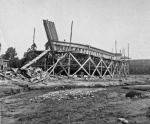 La goélette membrée
La goélette membrée
-
 La Saint-André sur la
La Saint-André sur la
rivière Richel... -
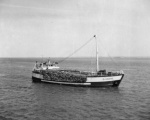 La Saint-André, charg
La Saint-André, charg
ée de «pitoune»... -
 Le capitaine Fernand
Le capitaine Fernand
Gagnon et l’ima...
-
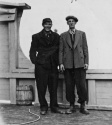 Le capitaine Fernand
Le capitaine Fernand
Gagnon et le ma... -
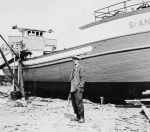 Le maître charpentier
Le maître charpentier
Philippe Lavoi... -
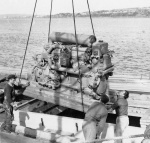 Le moteur est descend
Le moteur est descend
u dans la cale ... -
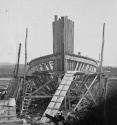 Les membres de devant
Les membres de devant
-
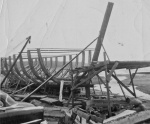 Les membres du centre
Les membres du centre
de la goélette... -
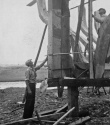 Philippe Lavoie vérif
Philippe Lavoie vérif
ie l’installati... -
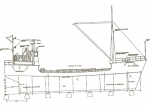 Plan de la goélette S
Plan de la goélette S
aint-André -
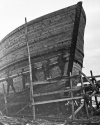 Pose de la dernière b
Pose de la dernière b
ordée, la parcl...
Catégories
Notes
1. The Robert dictionary suggests that it is related to the word goéland (seagull).
Bibliographie
Enquête ethnographique auprès de M. Claude Gagnon, novembre 2007 et avril 2008. L’auteure tient à remercier M. Gagnon de lui avoir fait partager ses souvenirs personnels de même que l’album familial de photographies.
Archives du Musée maritime de Charlevoix.
Bélanger, Diane, La construction navale à Saint-Laurent, île d’Orléans, Saint-Laurent, île d’Orléans, Bibliothèque David Gosselin, 1984, 149 p.
Bélanger, Diane, Concept d’interprétation et de mise en valeur de la goélette Saint-André, Saint-Joseph-de-la-Rive, Musée maritime de Charlevoix, janvier 2007, 17 p.
Desgagnés, Michel, Les goélettes de Charlevoix, Montréal, Léméac, 1977, 182 p.
Franck, Alain, Les goélettes à voiles du Saint-Laurent : pratiques et coutumes du cabotage, L’Islet-sur-Mer, Musée maritime Bernier, 1984, 166 p.
Gagnon, Hélène, Les chantiers maritimes de Charlevoix ltée, Saint-Joseph-de-la-Rive : synthèse historique et inventaire, septembre 1987, 67 p.
Therrien, Armand, L’historique de la goélette St-André, document inédit, Québec, 1978.

